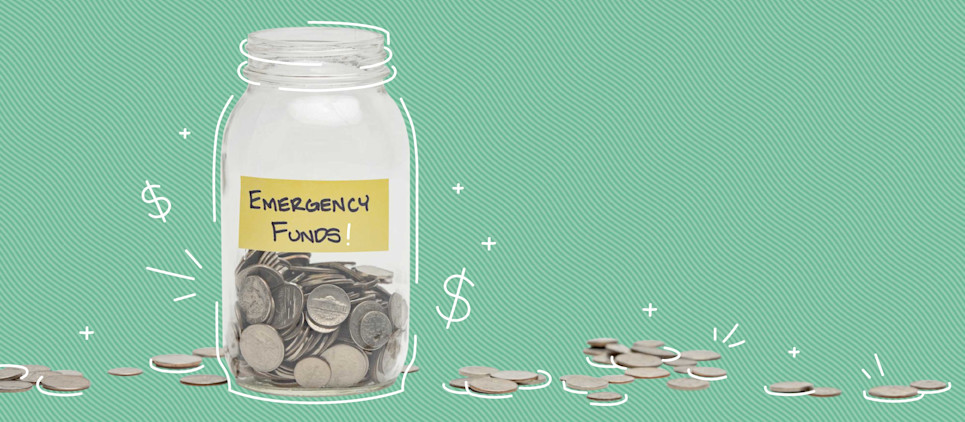Emergency funds: What they are, why you need one, and how to start one
Are you prepared for an unexpected expense? According to a 2016 estimate from the Federal Reserve, only 29 percent of Americans under the age of 35 have savings equal to three months of expenses. Learn why it’s so important to have a financial safety net, and how to build up an emergency fund.

Table of contents
What is an emergency fund?How much money should go into an emergency fund?What is an emergency fund for?Where should you keep your emergency fund?What is an emergency fund?
An emergency fund is liquid savings (i.e. savings that you can withdraw in cash, not investments) that you can draw upon in the face of unexpected expenses, such as job loss or injury. Financial experts recommend that everyone have an emergency fund: Unexpected events can happen to anyone, but having an emergency fund will provide you with the financial stability you need to handle them.
How much money should go into an emergency fund?
Financial experts recommend setting aside at least three months of basic living expenses in case of a job loss or major medical expense, and some recommend a safety net equal to six months worth of expenses.
How do you know what’s right for you? Start with three months. Then, take a look at your individual situation to decide if you need to add to your emergency fund. Some questions to ask yourself:
Would my health insurance cover a large medical expense?
Would it be easy for me to find another job with similar pay?
Would my job provide notice or severance pay if I were laid off, or my hours reduced?
Do I have other savings that I could dip into?
Do I want my emergency fund to cover just my bare-bones living expenses, or do I want to be able to continue my current quality of life even if I lose my job?
Is my income steady or variable?
Can I borrow money from family if I need to?

What is an emergency fund for?
It can be hard to save money when you don’t know what you’re saving for, and even harder to imagine a future financial hardship. But unexpected expenses happen to everyone. Without an emergency fund, an unexpected event might force you to dip into your retirement savings, or carry a balance on your credit card, getting trapped in a cycle of debt and unpaid bills. Here are the types of events we’re talking about:
Medical Expenses: According to the Federal Reserve’s survey, more than one-fifth of adults had a major unexpected medical expense in 2019, and an additional 18 percent of adults had unpaid debt related to medical expenses. Even if you have health insurance, a trip to the emergency room can cost hundreds (or thousands) of dollars.
Job loss: After medical expenses, job loss or reduction in hours is the next most common financial hardship among American adults. If you lose your job, having emergency savings will make it a lot easier to find your next job, since you won’t have to scramble to cover basic expenses like rent and food.
Small unexpected expenses: In 2019, 37 percent of adults said they would have to borrow money or sell something to pay for an unexpected $400 expense. Car repair, a trip to the vet, a broken phone screen—these things happen to everyone. With a solid emergency fund, life’s smaller unexpected expenses won’t throw your personal finances out of whack.

Where should you keep your emergency fund?
Your emergency fund should be liquid, meaning that you should be able to access it easily and without restrictions. (Don’t put your emergency savings in a mutual fund or other investment!) Keep your emergency fund in a savings account connected to your checking account for quick access when you need it. As your emergency fund grows, however, you may want to put it in a high-yield savings account.
3 Tips for starting an emergency fund
If you don’t have an emergency fund yet, don’t worry—it’s easy to start one.
Make room in your budget. When you create a personal budget, designate your emergency savings as one of your financial goals, and start saving as much as you can each month. Bonus: When you’re making your personal budget, you’ll find out how much you spend each month on basic living expenses, and you’ll know exactly how much to set aside.
Create a separate savings account. It’s a good idea to create separate savings accounts for all of your financial goals. Keep your emergency fund separate from other savings accounts you might have, so that you can track your progress (and remove the temptation to dip into your emergency fund for other spending).
Use a windfall. If you unexpectedly find yourself with extra cash (from, say, a large tax refund), your emergency fund might be the best place to put it. Unlike other long-term financial goals like saving for retirement, which can happen over time, an emergency fund is something you want to set up ASAP, since the whole point is to be prepared for a large expense that might occur in the short term.
Bungalow offers private rooms in shared homes that are less expensive than living alone. Find a Bungalow near you.
Ready to find your next home?
Move-in ready homes and a built-in community so you can feel at home, together — wherever you are.
Suggested articles



